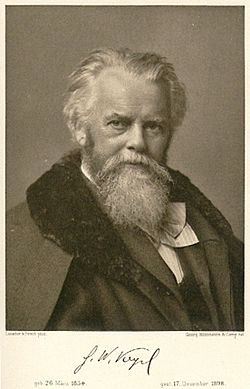Hermann Wilhelm Vogel facts for kids
Quick facts for kids
Hermann Wilhelm Vogel
|
|
|---|---|

Hermann Wilhelm Vogel, with signature in partial Kurrent handwriting script
|
|
| Born | 26 March 1834 Dobrilugk, Kingdom of Prussia
|
| Died | 17 December 1898 (aged 64) |
| Nationality | German |
| Alma mater | University of Berlin |
| Scientific career | |
| Fields | Photochemistry, photography |
| Institutions | Technical University of Berlin |
| Doctoral advisor | Karl Friedrich August Rammelsberg |
| Doctoral students | Alfred Stieglitz |
Hermann Wilhelm Vogel (born March 26, 1834 – died December 17, 1898) was a German scientist. He studied how light affects chemicals (this is called photochemistry). He was also a talented photographer. Vogel made a very important discovery called dye sensitization, which changed photography forever.
Contents
Becoming a Scientist: Hermann Vogel's Education
After finishing school, Hermann Vogel went to the Royal Industrial Institute in Berlin. In 1863, he earned his Ph.D. (a high university degree). His main teacher was Karl Friedrich August Rammelsberg.
Vogel's Ph.D. paper was about how silver chemicals react to light. It was titled Reactions of Silver Chloride, Silver Bromide and Silver Iodide with Light and the Theory of Photography. This paper showed the start of his deep research into how photography works.
From 1860 to 1865, he worked at the mineralogical museum at the University of Berlin. Later, in 1884, he became the director of the photo-technical laboratory there. Starting in 1864, he was a professor at Berlin's Technische Hochschule. This school later became the Technical University of Berlin. He was the first to teach photography as a special subject there.
Dye Sensitization: A Big Photography Breakthrough
In 1873, Vogel made a huge discovery called dye sensitization. This was a major step forward for photography. Before his discovery, photographic films were mostly sensitive to blue, violet, and ultraviolet light. They barely reacted to green light and almost not at all to other colors.
Vogel was testing some special photographic plates from England. He was surprised to see they were more sensitive to green light than to blue. He investigated why. His experiments showed that a yellow substance in the film was causing this. This substance was likely added to stop light from bouncing around inside the film.
When he washed the yellow substance out with alcohol, the film lost its special sensitivity to green. Then, Vogel tried adding small amounts of different aniline dyes to new films. He found several dyes that made the films sensitive to different parts of the light spectrum. These sensitivities matched the colors the dyes themselves absorbed. Because of Vogel, photographers could now make films sensitive to green, yellow, orange, and even red light.
This discovery made photography much more useful for science. It also helped create better black-and-white photos of colorful subjects. Most importantly, it made actual color photography possible.
In the early 1890s, Vogel's son, Ernst, helped a photographer named William Kurtz. They used dye sensitization and three-color photography to create halftone printing. This allowed full-color pictures to be printed cheaply in large numbers.
Other Interesting Activities
Besides his important work in photography, Vogel also taught Alfred Stieglitz. Stieglitz later became a very famous American photographer. Vogel taught him between 1882 and 1886.
Hermann Vogel also went on at least two photography trips to Egypt. He also traveled to Italy and possibly to Asia for his work. In 1864, Vogel started a magazine called Photographische Mittheilungen. He was its publisher until he passed away.
Some of his inventions became widely used. These include his silver tester, a special light meter for printing, and a universal spectroscope. He also visited the United States twice, in 1870 and 1883.
See also
 In Spanish: Hermann Wilhelm Vogel para niños
In Spanish: Hermann Wilhelm Vogel para niños

